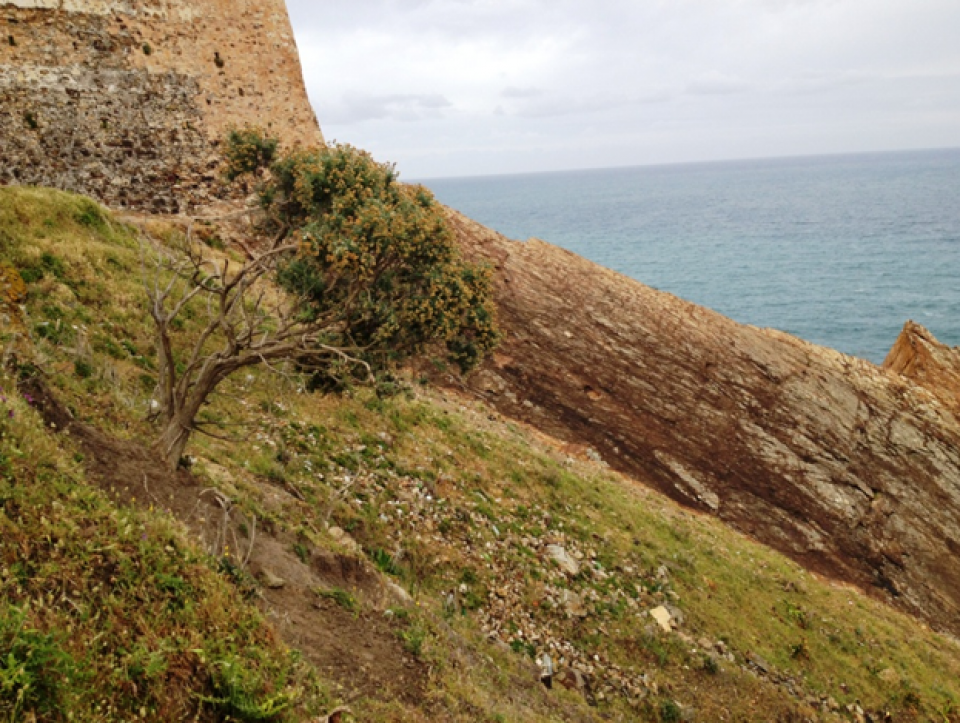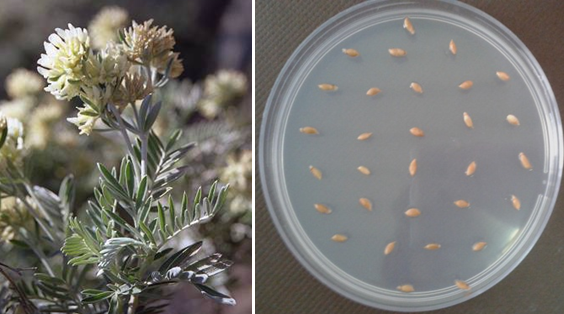
Anthyllis barba-jovis is a rare evergreen shrub belonging to the family of Fabaceae and could be found in different habitats, especially along steep rocky cliffs. It is an endemic species originating from the west-central regions of the Mediterranean basin. It’s located in France, Italy, Croatia, Algeria, and Tunisia and grows on low altitudes of the Mediterranean littoral rocks. The main objective of this work is to control the seed propagation techniques of Anthyllis barba-Jovis L.
The Anthyllis barba-jovis is resistant to salty sea spray and has a good capacity to resist drought. It is used as an ornamental plant with its long-lasting and delicate flowering. Anthyllis barba-jovis is a compact shrub that measures 0.30 to 1.50 m in the wild but can grow more when cultivated. This work is a part of the project ECOPLANTMED (www.ecoplantmed.eu).
The average weight of 100 seeds is 0.3 g (100 g = 33,300 seeds). Seed harvesting is done manually by harvesting ripe fruit directly from the branches (July-September). Chemical scarification seeds with sulfuric acid (96% H2SO4) for 15 minutes yielded very satisfactory results. The germination tests were conducted in agar cultures (1%) at a temperature of 20°C (12h light/12h dark) for 1 to 2 weeks. The average germination rate exceeds 85%. Good results were also obtained with alternating temperature 25/10°C or 15°C (Bacchetta et al., 2015). Abrasive paper can also be used for mechanical scarification. The seeds are orthodox, so they can be dried at 15°C and 15% relative humidity and stored at 5°C for several years.
The Anthyllis barba-jovis requires a sunny exposure as well as a drained stony soil and little humus. It can grow in calcareous soil and supports sea spray. The seeds are better to be used fresh. They are soaked in lukewarm water for half a day, and then sown in a sandy mixture kept slightly moist for 1 to 2 weeks. As soon as the seedlings reveal small roots through the holes in the pot, they must be transplanted into a deep individual pot. They must be quickly transplanted in the field before their taproot rolls too much into the pot.
After transplanting in the open fields, it takes a while to settle, develop deep roots, and become resistant to drought. It needs draining soil not too heavy. The forage resource of Anthyllis barba-jovis is good in spring. No form of protection at the national level even at the Mediterranean basin scale except in France and Croatia, the collection and selling are prohibited.
This work aims to preserve the species in its natural habitat and to best control seed multiplication. It could be more developed by creating a testing field to observe the capacity of the species to adapt to different conditions. This plant has a durable and delicate flowering, and it shows strong resistance to drought. These results make it possible to better understand the germinative behavior of this species, to better preserve and conserve it for future generations. In vitro multiplication tests of this species must be carried out to better master the techniques of its germination.
Issam Touhami, issam_touhami@yahoo.fr, www.inrgref.agrinet.tn
Salma Sai-kachout, salmasey@yahoo.fr , www.inrat.agrinet.tn
Ali Khorchani, ali_el_khorchani@yahoo.fr, www.inrgref.agrinet.tn
Abdelhamid Khaldi, khalditn@yahoo.fr, www.inrgref.agrinet.tn
Further information
This work is a part of the project ECOPLANTMED (www.ecoplantmed.eu)
Bacchetta et al. 2015. Manual for the propagation of selected Mediterranean native plant species. Ecoplantmed, ENPI, CBC-MED. Christophe ZREIK. Marzo A, Herreros R, Zreik Ch (Eds.). pp 127. Available from :https://www.researchgate.net/publication/283665747_Manual_for_the_propagation_of_selected_Mediterranean_native_plant_species [accessed Dec 07 2019].
Salma Sai

Salma Sai
